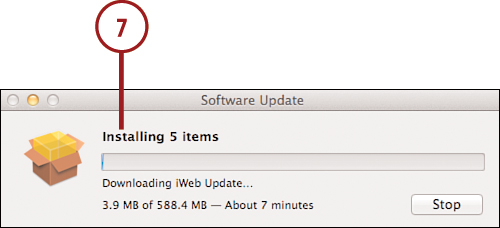8. Installing and Managing Software on Your MacBook
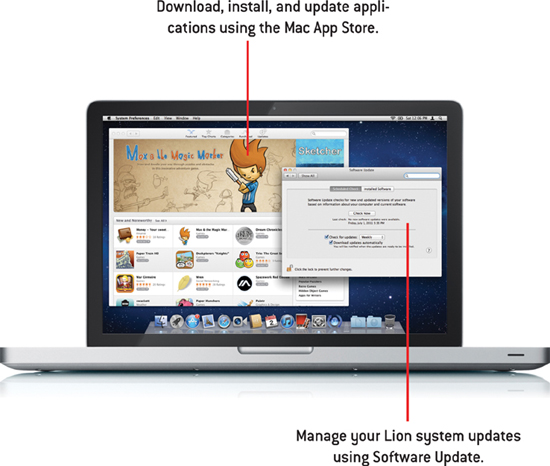
In this chapter, you’ll learn how to install applications on your MacBook and keep Lion up to date, including:
• Browsing the Mac App Store
• Downloading and Maintaining App Store Applications
• Downloading and Installing Non-App Store Software
• Working with Mac OS X software distribution formats
• Scheduling System Software Updates
Introduction
Up to this point in the book, you’ve been looking at software that came as part of OS X Lion. That’s a bit limiting, don’t you think? There is a wide world of software waiting to enhance your computing experience—including upgrades to Lion itself.
Through the use of the Mac App Store and Software Update application, you’ll be able to install new applications, keep them up to date, and keep your Mac running smoothly and securely. When that isn’t enough, you can turn to thousands of other apps that run natively on your MacBook.
Mac App Store
Applications make a Mac a Mac. As intangible as it is, there is a certain “something” about using a Mac application that is rarely replicated on a Windows computer.
Once you’ve become accustomed to the day-to-day operation of your MacBook, you’ll likely want to begin installing third-party software. The easiest place to do this is through the Mac App Store. Like the popular App Store for iOS devices, the Mac App Store is a one-stop-shop for thousands of apps that can be installed with point and click ease.
Logging into the App Store
To use the Mac App Store, you need a registered Apple ID—the same account you used to access iTunes in Chapter 6 will work just fine. If you don’t have an ID, you can create one directly in the App Store. To log into the store, follow these steps:
1. Open the App Store application from the Dock or from the Applications folder.
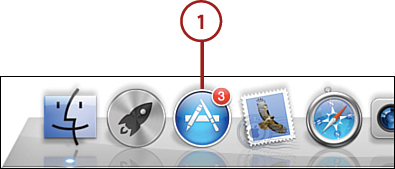
2. The App Store window opens.
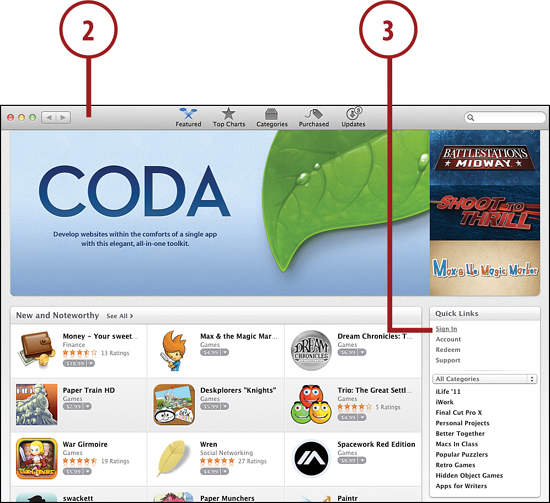
3. Click Sign In from the Quick Links on the right side of the page.
4. Provide your Apple ID and password in the form that appears.

5. If you do not have an ID, click Create Apple ID and follow the onscreen prompts.
6. Click Sign In to log into the App Store.
7. Your Login Status and links to your account information are shown in the Quick Links section.
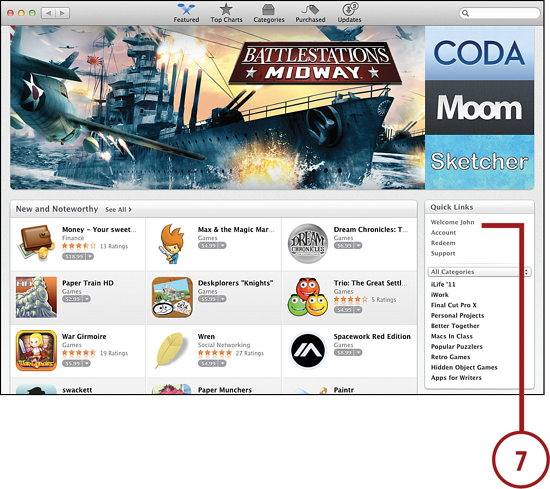
Browsing for Apps
Part of the joy of using the App Store is that browsing is simple and fun—and it works very much like a web browser. As you encounter links (such as, See All), click them to view more information. You can browse within a variety of categories that cover the gamut of what you can do on your MacBook:
1. Follow steps 1-7 of the previous task, “Logging into the App Store.”
2. Click the Featured icon to browse apps tagged by Apple as New and Noteworthy or Hot.
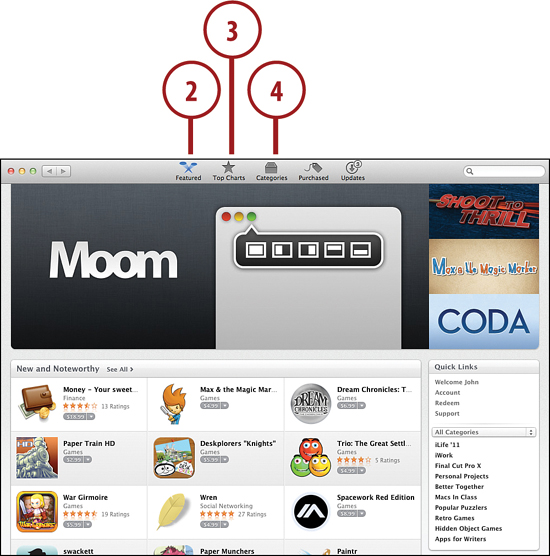
3. Click Top Charts to see the apps that are currently selling the best or being downloaded the most.
4. Click Categories to browse by the different types of apps (games, business, developer, and so on).
5. When you see an app you are interested in, click the icon or name.

6. A full page of information, including reviews, opens.
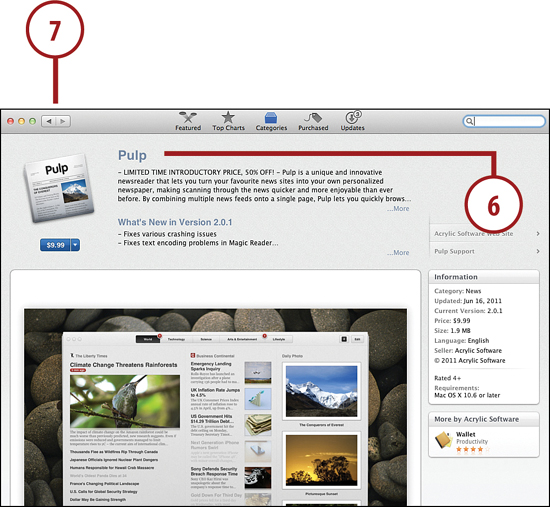
7. Use the Forward and Back buttons to move back and forth between pages, just like a web browser.
Searching for Apps
Sometimes you may know the app you want, but not know where it is located. In these cases, you can simply search the App Store:
1. Follow steps 1-7 of the previous task, “Logging into the App Store.”
2. Type a search term or terms into the field in the upper right corner. You can use application names, categories (type news, for instance), even author/publisher names.
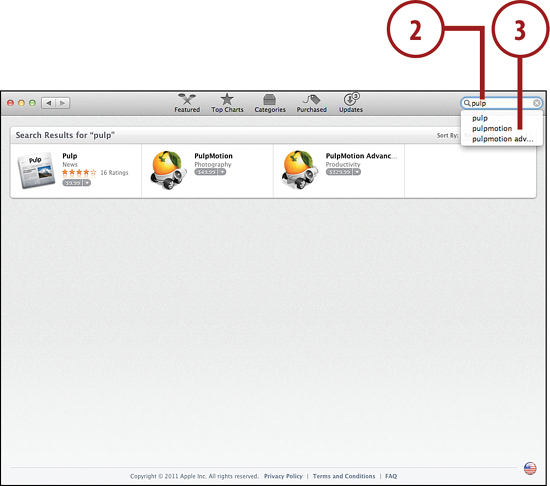
3. As you type, a list of possible searches appears. Click one if you’d like to use it, otherwise press return to use the search term you’ve typed.
4. The Search results are displayed.
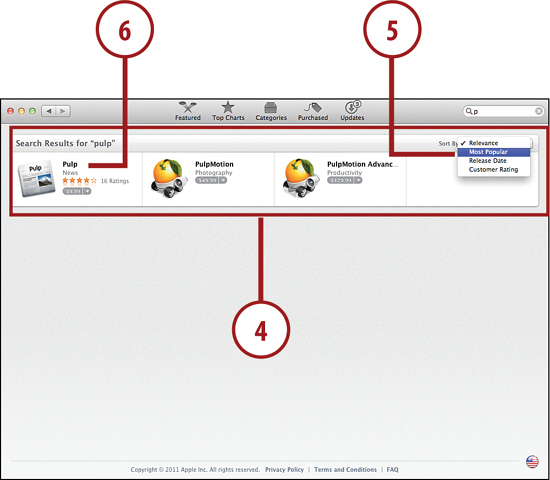
5. Use the Sort By menu to choose how the results are sorted within the window.
6. Click App Icons or Names to view more information.
Purchasing An App
When you’ve arrived at the decision to purchase an app, the process couldn’t be simpler. Follow these instructions to download an app and install it on your MacBook:
1. Browse or search for an app, as described in the previous tasks, “Browsing for Apps” or “Searching for Apps.”

2. From within the search/browse results or the larger application information page, click the App Price button.
3. The Price button changes to read Buy App. If the app is free, it will read Install App. Click the Buy App (or Install App) button.
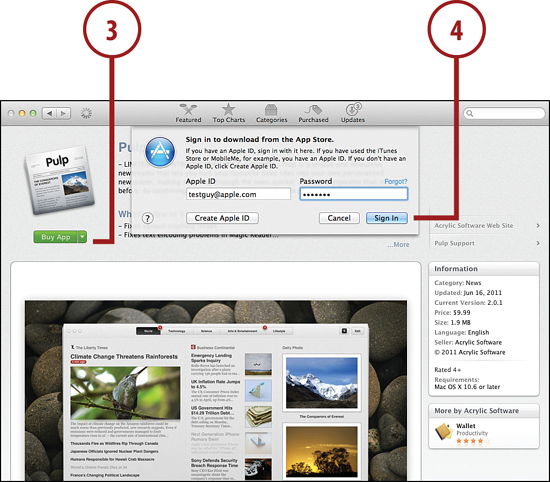
4. Provide your App Store Apple ID and password if prompted, and then click Sign In.
5. The application is immediately downloaded to your Applications folder and made visible in Launchpad.
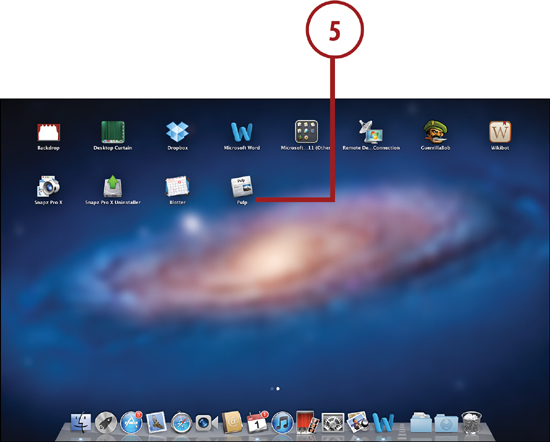
Checking for Updates
If you’re like many people (myself included), you install application updates only if the application tells you about them. Having to hunt down the app’s website, see if there is an update, figure out how to upgrade...it’s a process that’s easy to ignore. In the Mac App Store, updates are painless, and they come to you!
To check and install updates, do the following:
1. The App Store icon displays a counter badge listing the number of updates available to you.

2. Follow steps 1-7 of the “Logging into the App Store” task.
3. Click the Updates button in the App Store toolbar.
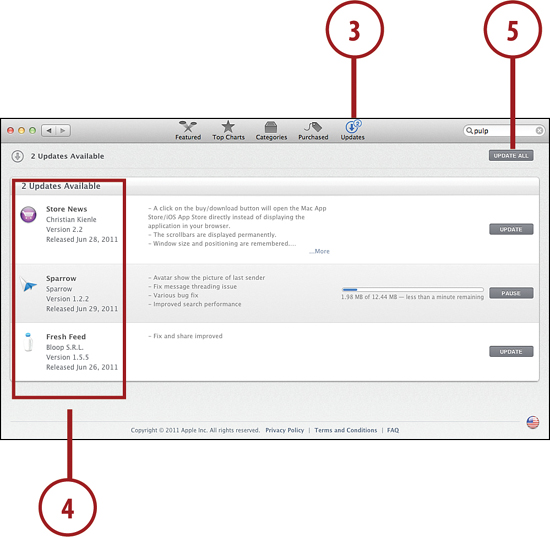
4. All your available app updates are listed.
5. Click the Update All button to update all applications at once.
6. Click an individual Update button to update just a single app.
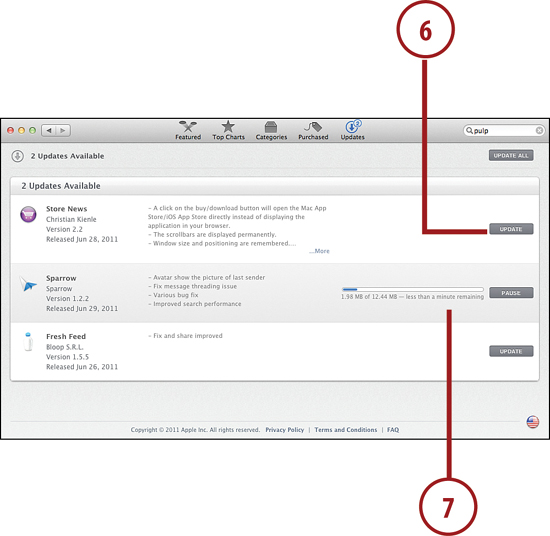
7. Update progress is shown in the App Store window, but you don’t have to wait to continue using your computer. The updates will be automatically installed in the background.
Reinstalling Apps and Installing Purchases on Other Macs
One of the best things about buying applications through the App Store is that you can install them on other Macs you own. No licensing hassles—just download and go. You can also re-install apps that you may have deleted in the past but want to start using again.
To download an app you’ve purchased but that isn’t installed, complete these steps:
1. Follow steps 1-7 of the “Logging into the App Store” task.
2. Click the Purchased icon at the top of the App Store window.
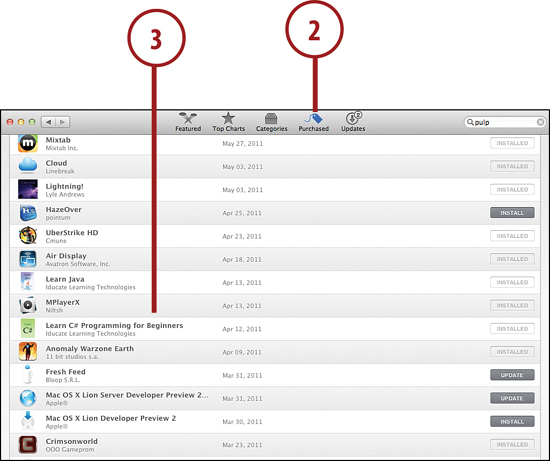
3. The Purchased App list is displayed, along with a button/label showing the status of each app.
4. Apps labeled as Installed are currently installed and up to date.
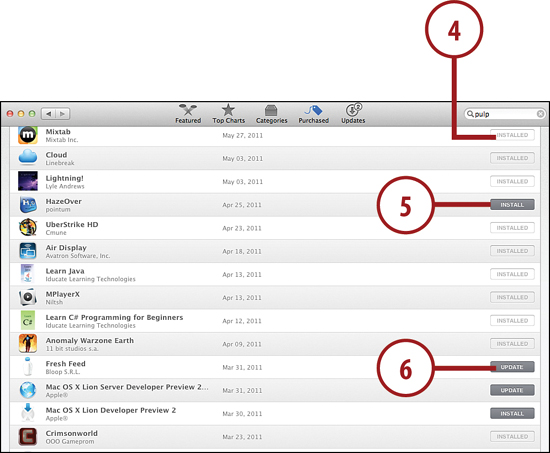
5. Click the Install button to install (or re-install) an app you already own.
6. Click the Update button to update a piece of software that is currently installed. (This functions identically to updating the software through the Updates view.)
Installing Non-App Store Applications
The App Store is great, but it doesn’t mean that it defines the limits of what you can do on your MacBook. There are certain restrictions in place on the App Store that make some pieces of software impossible to distribute through that site. There are also thousands of developers who want to sell and market their applications through their own websites.
Installing software from non-App Store sources is frequently a matter of browsing the web in Safari, clicking a download link, and copying the application to your Applications folder.
Unarchiving Zip Files
A decade ago, almost all Mac applications were distributed in a compressed archive format called SIT (StuffIt). Today, the Mac has adopted a standard used on Windows and other platforms called Zip files. A zip file can contain one or more highly compressed files.
To unarchive a zip file and access the contents, follow these steps:
1. Find the file that you want to unarchive.
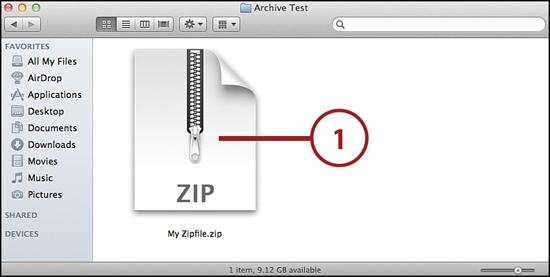
2. Double-click the file. Unarchiving can be virtually instantaneous or take several seconds, depending on the archive size.
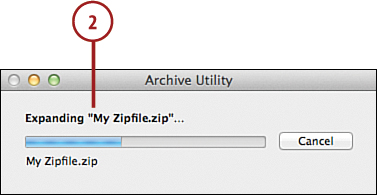
3. The contents of the archive are made available in the same folder where the zip file was located.
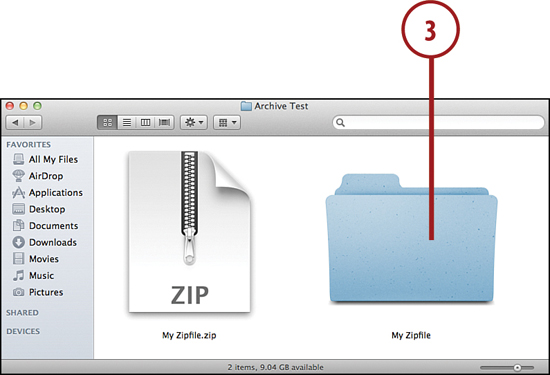
Accessing Disk Images
Sometimes applications are distributed on a disk image or DMG file. DMGs, when mounted on your system, act like a virtual disk drive. Files in a DMG must be copied off the disk image by way of an installer or a simple drag-and-drop process.
To mount and access the contents of a disk image, follow this process:
1. Find the Disk Image you want to access.
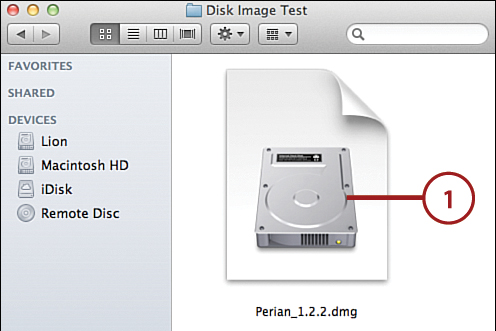
2. Double-click the DMG file. The disk image will mount and appear as a disk in the Finder.
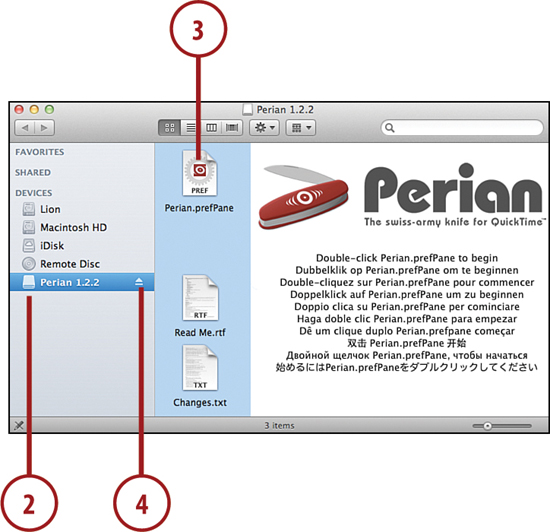
3. Access the files in the disk as you would any other storage device.
4. To eject the disk image, click the Eject icon beside the mounted disk in the Finder sidebar or drag it to the trash.
Useful Apps for Your MacBook
Apple writes great applications for maintaining a mobile lifestyle, but third-party publishers have created utilities that meet or exceed Apple’s own efforts. To get you started, I’d like to recommend a handful of non-App Store software packages that can make your MacBook experience even more enjoyable and productive.
Upgrading Your Operating System
Keeping your operating system up-to-date is important both from the standpoint of maintaining your system security and providing the best possible user experience.
With Lion, you can set an automatic update schedule that will check and prompt you with available updates on a periodic basis. Applying updates requires no additional configuration, although a reboot is occasionally required.
Setting an Update Schedule
To configure how frequently your MacBook will check for new software that is available from Apple, follow these steps:
1. Open the Software Update System Preference panel.
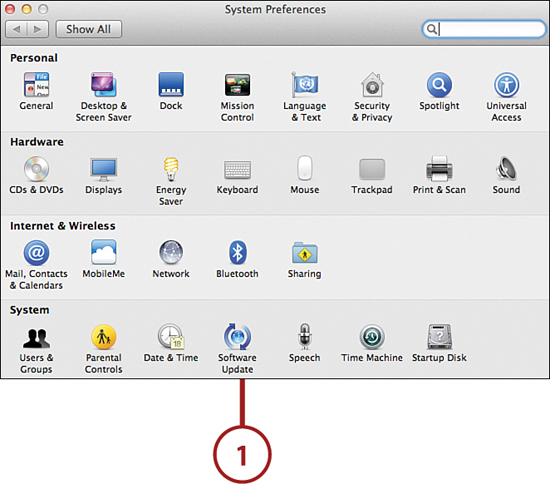
2. Click the Scheduled Check button at the top of the panel.
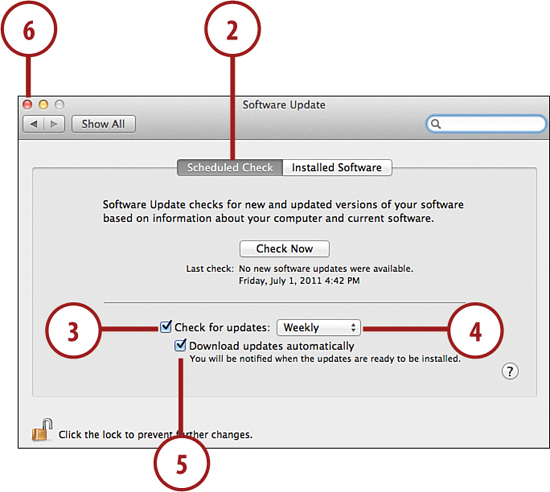
3. Select the Check for Updates checkbox to automatically check for system software updates.
4. Use the popup menu to choose between Daily, Weekly, and Monthly checks.
5. Check Download Updates Automatically to have your system download the update packages in the background so that they are available to install when you are.
6. Close the System Preferences by clicking the red Close button in the upper left corner.
Manually Checking for an Update
If you want to immediately check for updates, you can start the software update process at any time by doing the following:
1. Choose Software Update from the Apple menu.
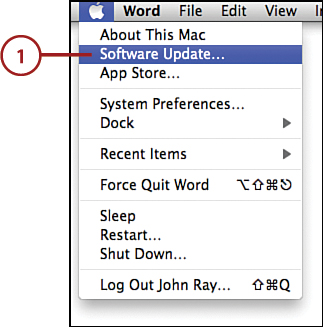
2. The Software Update utility launches and begins checking for updates.
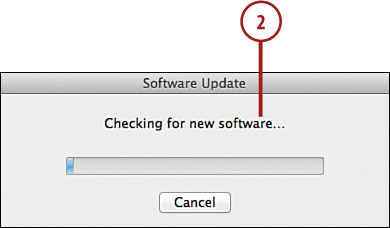
3. If updates are found, you can apply the system update by following the steps in the following “Applying a System Update” task.
Applying a System Update
When a system update has been detected (either through checking manually or an update schedule), you will be prompted to begin installation or delay until a later time. Follow this process to apply an available update:
1. When updates are detected, you are prompted to install or delay the update.

2. Click Not Now if you want to install the update at another time.
3. Click Show Details to list each update individually.
4. Click the name of an update to show the enhancements it provides.
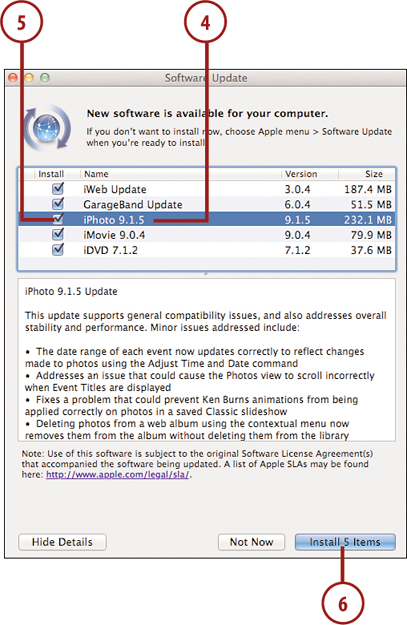
5. Uncheck any updates that you do not wish to install.
6. Click the Install button to begin installing the updates.
7. The upgrade process begins. You may be prompted to reboot your computer, depending on nature of the update.
